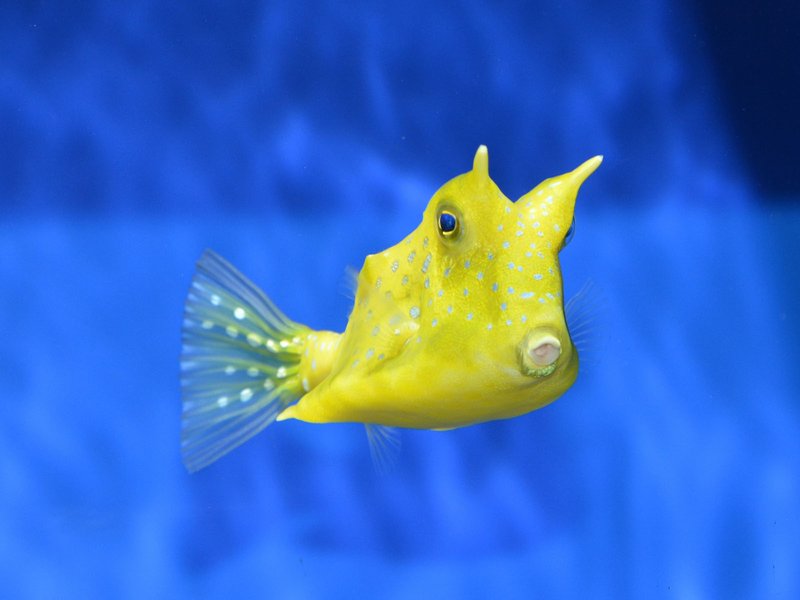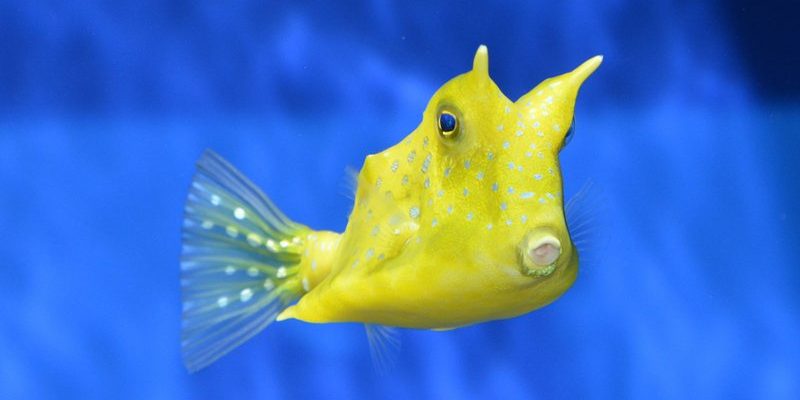
You’ve probably seen fish that make you do a double-take, but the Longhorn Cowfish is definitely one to remember. With its quirky shape, brilliant colors, and unique personality, this marine creature isn’t just another face in the ocean. It’s like a little underwater gem that blends both beauty and curiosity. If you haven’t encountered one yet, imagine a fish that looks like it’s been designed by a child—complete with horns and a cartoonish face!
But there’s more to the Longhorn Cowfish than just its playful appearance. It lives in the vibrant waters of the Caribbean and Pacific Oceans, where it plays an important role in its ecosystem. This fish isn’t just a pretty sight; it offers fascinating insights into marine life and behavior. Let’s dive deeper into the world of the Longhorn Cowfish and uncover what makes it such a unique and captivating creature.
Physical Characteristics
The first thing you notice about the Longhorn Cowfish is its odd but charming shape. It has a boxy body, almost like a small square, which can make it look like it’s always wearing a suit. One of its most distinctive features is its long, horn-like projections that extend from the top and bottom of its head. These aren’t just for show; they help the cowfish navigate its environment and even deter predators. Imagine wearing a crown of horns—pretty neat, right?
Color-wise, you’ll find Longhorn Cowfish dressed in shades of yellow and blue, with patterns that can resemble a mosaic. The vibrant colors are not just for aesthetics; they serve to camouflage the fish among coral reefs and seaweed. This clever tactic keeps them safe from lurking predators. They can grow to about 20 inches long, making them one of the larger members of the cowfish family. And while their size might seem intimidating, their temperament is generally quite peaceful.
Another fascinating aspect of their anatomy is their ability to puff up when threatened. This defensive mechanism helps them appear larger and more formidable to potential predators. So, while they might seem cute and harmless, they also have a way of saying, “Back off!” in the underwater world. It’s like trying to huff and puff to make yourself look bigger—an effective but amusing strategy!
Habitat and Distribution
The Longhorn Cowfish is primarily found in the warm, tropical waters of the Caribbean Sea and the Pacific Ocean. These fish prefer shallow marine environments, often residing around coral reefs, where they can find plenty of food and shelter. Think of these vibrant reefs as bustling cities filled with street vendors—they provide all the necessities for survival!
They thrive in waters between 10 to 80 feet deep, favoring areas with lots of rocks and coral formations. This environment allows them to dart in and out of crevices, avoiding predators while still hunting for algae and small invertebrates. When you picture a cowfish, imagine it gracefully gliding through the colorful underwater neighborhoods, snacking on anything it can find. They tend to stay close to the bottom, which further enhances their camouflage among rocks and corals.
However, like many marine species, the Longhorn Cowfish faces threats from habitat degradation. Coral reefs are under serious pressure from climate change and pollution, which can impact the cowfish population. Maintaining healthy oceans is crucial not just for the Longhorn Cowfish, but for the entire marine ecosystem. So, the next time you think about ocean conservation, remember that every small creature plays a big part in the underwater ballet!
Diet and Feeding Habits
You might be curious about what the Longhorn Cowfish actually eats. Well, their diet consists mainly of algae, small crustaceans, and other tiny invertebrates. Think of them as the vegetarians of the underwater world, munching on their greens while also enjoying some protein-rich snacks. They have a unique feeding strategy; they use their small, beak-like mouths to scrape algae off rocks and coral, which is quite a sight to see!
In addition to algae, they also actively hunt for small creatures that inhabit the reefs. This includes tiny shrimps and mollusks. Imagine being a cowfish, slowly swimming along the coral while using your keen eyes to spot dinner hiding among the colorful corals. Their playful nature makes feeding time look like a fun game, and they often hunt with a sense of curiosity, exploring nooks and crannies.
Interestingly, the Longhorn Cowfish has a pretty slow metabolism. This means they don’t need to eat as often as some other fish. They’re like that friend who’s perfectly happy with a light snack instead of a full meal. This slow approach to eating is part of their charm, helping them conserve energy and stay vibrant in their busy underwater world.
Behavior and Social Structure
The Longhorn Cowfish is known for its interesting behavior and social interactions. They are generally solitary creatures, often found swimming alone or in small groups. You might think of them as introverts at a party—happy to socialize but also perfectly content on their own. When they do interact, it’s typically during mating seasons or when they’re swimming in familiar territories.
When it comes to mating, the male Longhorn Cowfish displays colorful courtship behaviors to attract a female. This can involve swimming in circles or displaying vibrant colors to woo potential partners. Once paired, they engage in cooperative behaviors necessary for maintaining their bond. It’s like a dance where both partners know their steps and moves to impress each other.
Despite their somewhat robust appearance, Longhorn Cowfish have a gentle demeanor. They don’t usually engage in aggressive behavior. If threatened, instead of fighting, they prefer to puff up and swim away. Think of it as a peaceful protest—a non-confrontational way to handle issues without getting into a scuffle. This peaceful approach contributes to their unique personality in the marine world.
Conservation Status
The conservation status of the Longhorn Cowfish is quite concerning. Currently, they are classified as “Least Concern” by the IUCN, which sounds good, but it doesn’t tell the whole story. While they’re not in immediate danger, their habitats—especially coral reefs—are facing serious threats from climate change and pollution. Think of it as living in a beautiful house that’s slowly falling apart; you might be okay for now, but who knows for how long?
Conservation efforts are essential to ensure the Longhorn Cowfish continues to thrive in its natural habitat. Protecting coral reefs and preventing pollution can help not just the cowfish but all marine life that relies on these lush environments. Community awareness and participation in conservation programs can make a real difference. Whether it’s participating in beach clean-ups or advocating for marine protected areas, every little effort counts!
It’s essential to spread knowledge about the importance of protecting these ecosystems. When we come together to care for our oceans, we’re indirectly looking after the Longhorn Cowfish and its colorful neighborhood. Remember, a healthy ocean equals a happy cowfish!
Interesting Facts
| Scientific Name: | Tyleria trigloides |
| Average Size: | Up to 20 inches long |
| Habitat: | Shallow waters of the Caribbean and Pacific Oceans |
| Diet: | Algae and small invertebrates |
| Lifespan: | Up to 12 years in the wild |
| Colors: | Yellow and blue with intricate patterns |
FAQ
What is the Longhorn Cowfish’s primary habitat?
The Longhorn Cowfish primarily inhabits warm, tropical waters found in the Caribbean Sea and the Pacific Ocean. They prefer shallow regions, usually around coral reefs where they can find plenty of food and protection from predators. This vibrant environment is essential for their survival, providing both nourishment and shelter.
How do Longhorn Cowfish defend themselves?
Longhorn Cowfish have a fascinating defense mechanism. When threatened, they can puff up their bodies to appear larger and more intimidating to possible predators. Additionally, their horn-like projections can deter potential threats, serving as a warning to stay away. It’s like putting up a “No Trespassing” sign in their underwater world!
What do Longhorn Cowfish eat?
The diet of a Longhorn Cowfish mainly consists of algae, small crustaceans, and other tiny invertebrates. They use their beak-like mouth to scrape algae off rocks and corals, making them efficient grazers in their ecosystem. They balance their vegetarian diet with protein from hunting small creatures in their environment.
Are Longhorn Cowfish social creatures?
Generally, Longhorn Cowfish are solitary animals, although they may be seen in small groups during certain periods, especially during mating seasons. They can display colorful courtship behavior to attract partners, showcasing their vibrant personalities while still maintaining a sense of detachment when it comes to socializing.
What is the lifespan of a Longhorn Cowfish?
In the wild, Longhorn Cowfish can live for up to 12 years. However, their lifespan can be affected by environmental factors, such as habitat degradation and availability of food. Like many other marine creatures, a healthy ecosystem significantly contributes to their longevity.
Is the Longhorn Cowfish endangered?
Currently, the Longhorn Cowfish is classified as “Least Concern” by the IUCN. While they are not in immediate danger, their populations can be negatively impacted by threats like pollution and habitat loss. Protecting their coral reef environments is crucial for sustaining their populations.
Can Longhorn Cowfish be kept in aquariums?
Yes, Longhorn Cowfish can be kept in aquariums, but they require larger tanks with plenty of swimming space and hiding spots. Due to their unique dietary needs and specific environmental requirements, it’s essential for potential aquarium owners to research thoroughly and create a habitat that mimics their natural conditions.
How do Longhorn Cowfish reproduce?
Longhorn Cowfish reproduce by laying eggs, and the mating process often involves elaborate courtship displays. The male will showcase vibrant colors and swim in circles to attract a female. Once paired, they will engage in cooperative behaviors that help them bond during the breeding season.
What threats do Longhorn Cowfish face?
Longhorn Cowfish face several threats, including habitat degradation, pollution, and climate change affecting coral reefs. Protecting marine ecosystems is vital for the survival of these and many other species. Community involvement in conservation efforts can make a meaningful difference in ensuring their future.
Do Longhorn Cowfish have natural predators?
Yes, Longhorn Cowfish have natural predators, including larger fish and sharks. However, their unique defense mechanisms, like puffing up and their protective horns, can help deter some of these threats. Yet, young cowfish are more vulnerable and must remain cautious as they swim through their vibrant underwater neighborhoods.

